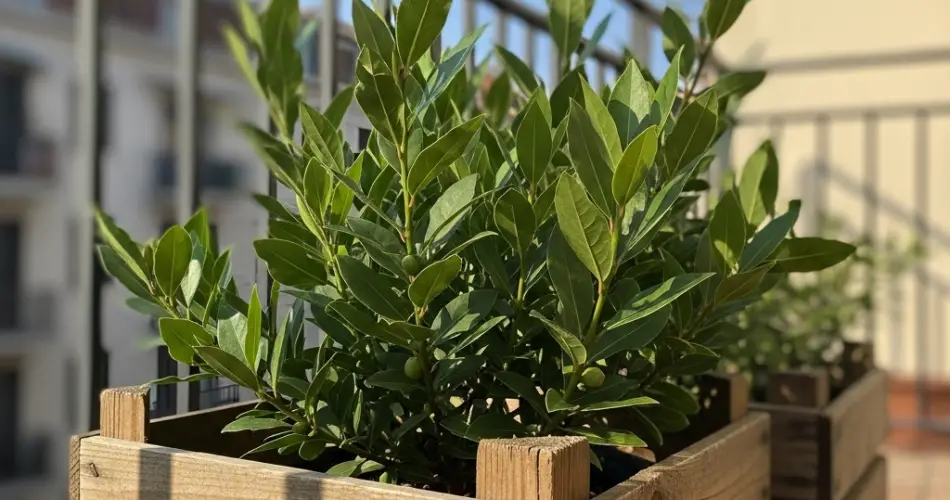Bay laurel (Laurus nobilis) is a fragrant evergreen tree valued for its aromatic leaves, which are commonly used in cooking for soups, stews, sauces, and marinades. Beyond its culinary applications, bay laurel also adds visual appeal to gardens and balconies with its glossy, dark green foliage. For those with limited outdoor space, growing bay laurel in balcony crates offers a practical and decorative solution.
Container gardening allows urban gardeners to cultivate bay laurel trees in confined areas while maintaining control over soil quality, watering, and sunlight exposure. Balcony crate gardening is particularly suitable for small spaces, patios, and rooftop terraces, enabling gardeners to enjoy fresh bay leaves without requiring a traditional yard.
Selecting Crates and Preparing the Balcony
Choose a sturdy crate that can accommodate the weight of soil, water, and a growing bay laurel tree. Wooden crates are ideal for their natural aesthetic and breathability, while plastic crates offer durability and ease of maintenance. Ensure the crate has adequate drainage by drilling multiple holes in the bottom, preventing water from pooling around the roots.
Position the crate in a sunny location, as bay laurel thrives in full sun but tolerates partial shade. South- or west-facing balconies are optimal. Elevating the crate slightly on a plant stand can improve air circulation and make harvesting more convenient.
Soil Preparation for Bay Laurel
Bay laurel grows best in well-draining, fertile soil. A high-quality potting mix enriched with compost or organic fertilizer provides essential nutrients for healthy growth. Avoid heavy garden soil, which can compact in containers and restrict root expansion.
Add a layer of gravel or small stones at the bottom of the crate to enhance drainage. Fill the remainder with potting mix, leaving a small gap at the top for watering. Proper soil preparation ensures robust root development, lush foliage, and aromatic leaves.
Planting Bay Laurel in Crates
Bay laurel can be grown from young nursery plants, cuttings, or seeds:
-
Nursery plants: Transplant young trees into the crate, spacing them to allow airflow and room for growth. Firm the soil around the roots and water thoroughly.
-
Cuttings: Take semi-hardwood cuttings in late spring or early summer, dip in rooting hormone, and plant in a well-draining potting mix. Keep the soil moist until roots develop.
-
Seeds: While possible, growing bay from seeds is slower and requires patience, as germination can take several weeks.
Proper planting and spacing promote healthy foliage, strong stems, and a continuous supply of bay leaves.
Watering and Maintenance
Container-grown bay laurel requires consistent watering, especially during the first year as roots establish. Keep the soil evenly moist but avoid waterlogging, which can lead to root rot. Crates tend to dry faster than ground containers, so check soil moisture regularly.
Occasional misting can help maintain humidity and support healthy leaves. Mulching the soil surface also conserves moisture, suppresses weeds, and regulates soil temperature.
Sunlight and Fertilization
Bay laurel thrives in bright light, needing at least 4–6 hours of direct sunlight daily. Proper light exposure ensures strong growth, dark green leaves, and the development of the herb’s characteristic aroma.
Container trees benefit from regular fertilization, as nutrients in crates are used quickly. Apply a balanced liquid fertilizer every 3–4 weeks or use slow-release organic fertilizers. Organic options such as compost tea or seaweed extract promote healthy foliage and enhance flavor. Avoid excessive nitrogen, which encourages leafy growth at the expense of plant structure.
Pruning and Harvesting
Pruning bay laurel maintains a manageable size for balcony containers and encourages bushier growth. Remove yellow or damaged leaves, as well as any weak or crossing branches, to improve airflow and prevent disease.
Leaves can be harvested as needed for culinary use. Pick mature, dark green leaves from outer branches, leaving inner leaves intact for continued growth. Fresh leaves can be used immediately or dried for future use. Regular harvesting encourages continuous production and keeps the tree healthy.
Tips for a Thriving Balcony Bay Laurel Tree
-
Rotate crates occasionally to ensure even sunlight exposure.
-
Monitor for pests such as aphids or scale insects and treat naturally when needed.
-
Check the structural stability of the crate and balcony setup to prevent accidents.
-
Consider companion planting with other herbs in adjacent crates to maximize space.
Final Thoughts
Growing bay laurel in balcony crates is a practical and aesthetically pleasing way to cultivate fresh, aromatic leaves at home. Container gardening maximizes limited space, provides control over growing conditions, and ensures a continuous supply of flavorful herbs for cooking.
With well-prepared soil, consistent watering, adequate sunlight, and routine pruning, your balcony bay laurel tree will thrive, providing both culinary benefits and decorative greenery. This method transforms a simple balcony into a productive, fragrant, and visually appealing mini-garden, perfect for urban living.



